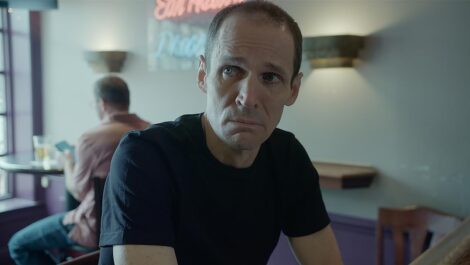There is a notable absence when it comes to disability. Whether you are born with it, or it overtakes you through time, the feeling of something missing is palpable. It’s a not insignificant part of what makes it such a terrifying concept to so many. They cannot wrap their heads around the lacking. Around the needing to find other ways to navigate a world so aggressively geared to satisfy only the most able minds and bodies possible. Regardless of whether an accommodation would ease the lives of everyone, often it seems the request or requirement for one is seen as a failing on the part of the person in need. It’s a societal problem that leads to all sorts of other kinds of insidious nonsense, like the idea that asking for help for anything makes someone a weaker person. The idea that disability is some kind of monstrous burden to be squashed, and killed, and cured, and wiped away, even if the disability is not curable, and getting rid of it is tantamount to losing the person affected completely.
I am by no means saying that disability itself is not a burden. It very well can be, particularly if you go from being seen as a healthy, physically and mentally able person to someone who loses control of their formerly very well-regulated faculties. It can be scary beyond all imagining, and to some it has even seemed a fate worse than death itself. But, much like death is understood to be, disability is the great equalizer. At one point or another in all of our lives, everyone is disabled for however brief or long a time. And it can happen when you least expect it, in small ways and big, sliding under the radar, completely undetectable until it manifests.
Written, produced, and directed by Mike Taylor, THERE IS A MONSTER is one man’s story of a haunting only he can see. Jack, a talented portrait photographer (Joey Collins) has just scored a big job that promises all sorts of new possibilities for his future. Even his tense marriage begins to show signs of rekindling the spark between him and his wife Carol (Ena O’Rourke). His protegee and assistant, Billy (Jesse Milliner) is developing his own talented eye for lighting and composition. Everything, in short, is looking up. Until Jack begins seeing a monster who he soon believes is hunting him down. A humanoid-looking, untouchable shadow of darkness that, when it makes contact with his body, short circuits his ability to function. First it hovers over him in sleep and steals away his ability to speak at his regular pace and tone, then it grabs him by the wrist and saps his motor function there, and generally becomes progressively more aggressive as time passes, looking to take away all his functionality and success he has only just gotten a taste of.
As the intensity increases, Jack is more afraid, desperately trying to reach out to anyone who might believe that there is a monster hunting him down. His closest friends and his wife are supportive of his idea to his face but coordinate with one another to try to understand the real truth when he is not around. They think he is hallucinating, losing control of his body and mind almost in one fell swoop. No matter how much he insists, the reality they see and the reality he sees will seemingly always be two entirely different experiences. The best they can do is be there for him however they’re able, in whatever physical or emotional way he needs, while they reckon with the loss of the man they have known for years, and the manifestation of a series of new obstacles and an entirely unfamiliar person.

That’s how it is, though, really. No matter how or when the disability appears or manifests, as soon as it strikes you are thrust into a whole new universe of understanding and navigating even the smallest elements of the world. THERE IS A MONSTER is inspired by and dedicated to Taylor’s own sister, and the love and heartache at the center of that experience is palpable through the entire film. Particularly as a disabled viewer, watching Jack fight against the loss of bodily control was gut-wrenching even as it was recognizable.
My favorite, starkest moments of comparison in the film came at the beginning, when Jack is celebrating getting what seems to be his first big breakout job from the slog of corporate headshots, and toward the end during his final onscreen confrontation with the monster that has been haunting his home and hunting his body. As he celebrates, he does so with the involvement of his entire body. Flailing arms, dancing feet, expressive facial muscles; all very common actions, carried out without much conscious thought when your body is able to do it. In the moment it seems like a flash of joy, certainly, but nothing particularly out of the ordinary. And then the movie progresses, and we watch him change, and fear, and rage, until it comes time for the final confrontation with the monster. In this moment, there are two entirely different realities playing out simultaneously. In one, Jack is conquering his demons, using brute force to beat the monster into submission even as it still appears just slightly incorporeal. In another, he is hardly able to move any part of his body at all, crumpled on the floor to be found by a loved one when they arrive home.
There is no way to fully articulate how accurate these distinct realities are. Even at my weakest I dreamed I was entirely capable of moving my body in exactly the same way, with exactly the same ferocity and passion as any of my able-bodied counterparts. Sometimes, when I walk, I feel as though I am walking with exactly the same gait as anyone else around me. I can’t, of course, move in the same way or for the same length of time with the same kind of exertion as other people, and my gait announces my presence long before anyone can take the time to get to know me. But that’s the dissonance, isn’t it? You can feel something, and its absence, all at once.
Right through to its final moments THERE IS A MONSTER keeps us in this space of tension. For Jack, there has always been a monster, whether anyone else saw it or not. For his loved ones it has been nothing more or less than a rapid, systematic decline of the one they love. The film’s final shot leaves us with Jack’s awareness of both things at once, and perhaps asks us to remember the terror outside ourselves that we can never imagine.
THERE IS A MONSTER is an unusual yet tender dive into a nightmare that is close to many. It is also an experiment in the depiction of radical empathy for those around us, and a reminder that we are all humans seeking comfort and understanding even as we’re forced into isolating circumstances.
Tags: Disability, Disabled Horror, Ena O'Rourke, Gravitas Pictures, Jesse Milliner, Joey Collins, Mike Taylor, There Is A Monster



No Comments